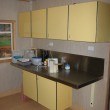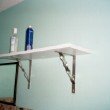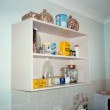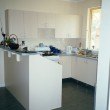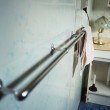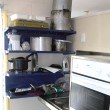B5.3 Storage areas in the house
Lack of storage can be inconvenient in a house with a small population but when a house population increases, the availability of storage may impact on the safety and health of residents.
When houses are crowded, and several families are sharing the same house, the pattern of living changes. Each family may live in a bedroom, storing all their private belongings there. They may have to shower, assist children wash and change clothes all within the privacy of the shower area. This increases the need for storage in the shower area to hang clothes and towels to keep them off wet floors, place soap and shampoo in the shower for immediate use returning them to the bedroom after use.
Data from over 6,000 houses show a lack of basic storage (towel rails, hooks, roll / soap /shampoo holders, shelving) in shower, basin, bath, toilet and laundry areas.
In remote communities, toilet rolls may be very expensive to buy. They need to be kept dry and off the toilet area floor. This will require a robust toilet roll holder (present & OK in 63% of houses) and a high storage shelf (present & OK in 52% of houses) for additional stored rolls. If these simple storage provisions are lacking, the likely impact will be no useable toilet roll in the house and substitution of toilet paper with rags or newspaper leading to a greater chance of drainage system blockages.
Storage is discussed in other sections of the Guide, particularly in B.4 ‘Improving nutrition, the ability to store, prepare and cook food’ and B.6 ‘Reducing the negative effects of animals, insects and vermin’. Important issues that relate to storage are summarised below.
Design and Specification
Ensure
- B5.3 .1.
high level, secure storage is provided in bathrooms and laundries for medicines and chemicals, to prevent accidental poisoning
- B5.3 .2.
some secure storage is provided that could be used by people with disabilities
- B5.3 .3.
there are towel rails, hooks and shelves for storage of clothes, towels and toiletry items in bathrooms, to prevent these items being placed on the floor where they could block drains
- B5.3 .4.
kitchens include high level shelves and cupboards for storage of food and utensils away from dogs, cockroaches, rats and other vermin
- B5.3 .5.
there are cupboards in bedrooms, hall ways and the laundry, to prevent clothing and bedding being stored on the floor where it is at risk from worms and mites carried by animals and other bacteria that can result in transmission of disease
- B5.3 .6.
shelving materials are strong and resistant to damp, mould, rot and insect infestation.
Consider
- providing lockable kitchen cupboards or a lockable pantry
- in large households, providing each bedroom with a small lockable cupboard for secure storage for medicines
- providing cupboards that can be accessed by people with disabilities, including using easy to grip handles on cupboards and locating them to allow people with disabilities to reach them
- that bedrooms will probably be used by more than one person, and sufficient cupboards need to be provided to store the personal possessions of several people
- including lockable storage in living areas for residents to securely store televisions and other electronic items
- building ventilated and storm / cyclone proof, outside storage for lawn mowers, bins, car parts, hunting and fishing equipment, and fuel, to separate children from these potentially dangerous items and enable secure storage during cyclones or high winds
- providing dry storage for fire wood in houses that have wood burning heaters or stoves, in an accessible location, but not against the edge of the house where it can attract termites
- including reels or hooks for storing garden hoses above the ground, to reduce damage by animals, lawn mowers and grass trimmers
- securing sections of any verandah with wire mesh and a lockable door to store items such as vehicle tyres, garden tools and car parts.
Real world examples of Solutions
- B5.3 .1.
Quality control
- design drawings include the location and details of storage through the house and yard areas

- SKETCH DESIGN
COMPLETED DESIGN & SPECIFICATION
- SKETCH DESIGN
- all storage is designed and is made of materials as specified in the contract and is well secured

- COMPLETED DESIGN & SPECIFICATION
AT HANDOVER
FINAL COMPLETION
TRADE TEST
- COMPLETED DESIGN & SPECIFICATION
- all fittings and storage have been provided as specified in the contract and are secure, check in particular:
- bedroom storage areas
- shampoo and soap holders
- clothes hooks
- towel rails
- toilet roll holders
- shelves in the toilet and laundry
- all kitchen storage (for detail refer to section B4)
- outside and yard area storage
- fire wood away from the house walls

- AT HANDOVER
FINAL COMPLETION
- AT HANDOVER
- design drawings include the location and details of storage through the house and yard areas
Maintenance
As part of cyclical maintenance, check that:
- all storage and fittings are in good condition and secure
In particular check
- bedroom storage areas, shelves are secure and cupboard doors function
- shampoo and soap holders, are fitted and secure
- clothes hooks, are fitted and secure
- towel rails, are fitted and secure
- toilet roll holders, are fitted and secure
- shelves in the toilet and laundry are secure
- all kitchen storage (for detail refer to section B4) cupboards, drawers, shelving and pantries
- outside and yard area storage, all items stored can be secured in the event of a storm / cyclone

- Local Maintenance Team
- 24 Months
- all storage and fittings are in good condition and secure
In particular check
- bedroom storage areas, shelves are secure and cupboard doors function
- shampoo and soap holders, are fitted and secure
- clothes hooks, are fitted and secure
- towel rails, are fitted and secure
- toilet roll holders, are fitted and secure
- shelves in the toilet and laundry are secure
- all kitchen storage (for detail refer to section B4) cupboards, drawers, shelving and pantries
- outside and yard area storage, all items stored can be secured in the event of a storm / cyclone

